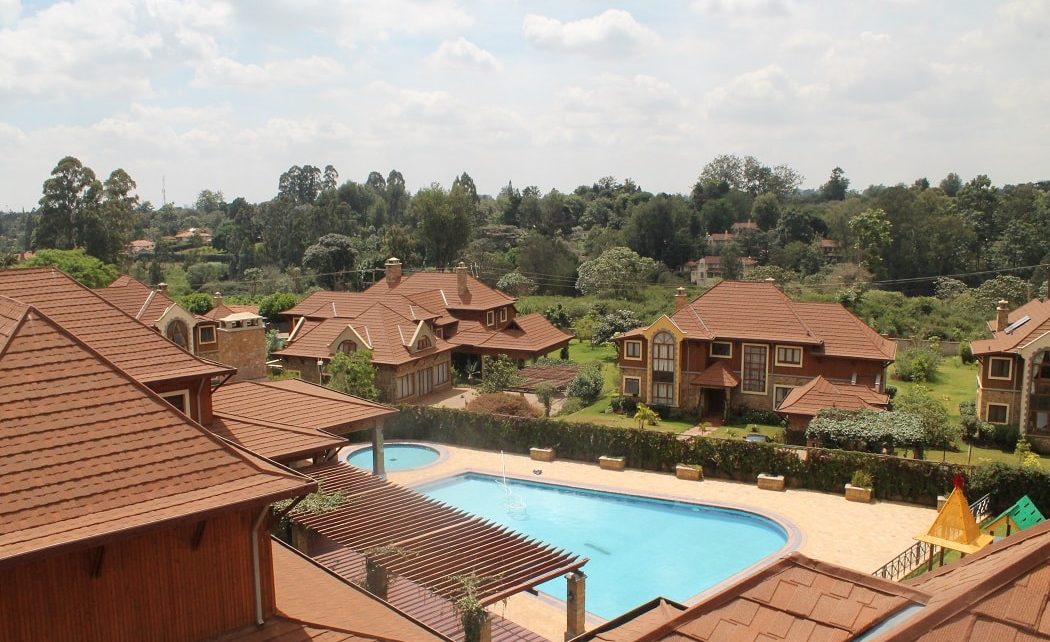There is a concrete difference between living in a gated community and existing in communal quarters-with a gate
By April K. Mbalu
Consulting Editor
@Undercover KE
Kenyans just love living in ‘gated communities’ which are now found in almost all residential areas including mabati slums. Only most Shags in rural Kenya are missing out in this gated action and there are many reason for the gradual preference for gated communities besides shared services like guards, gardeners and garbage collectors.
For starters, there is a yawning difference between living in a gated community and existing in communal quarters, with a gate.
This is because even slums in Nairobi are laughably being gated. Never mind it’s the corrugated iron sheet single rooms filled with factory reject mabatis on both ends of the earthen floor corridor. There is a communal toilet, bathroom and sink at the far end. You have to bend your over taxed head at the gate, a single entry mabati and timber affair.
The gate is mostly to deter thieves from stealing wet clothes from hanging lines. While asleep, residents are kept secure and far from burglars, wearing kavunja boots, by a small traveling bag padlock whose key is in the custody of the slum landlord- who occupies house number one-the largest of all. In gated communities in slums, rent rarely exceeds Sh2000. It is paid in cash to whoever is in house number one; the kids, a relative or either spouse.
My fellow Kenyans, this is not a gated community. It is a shanty dwelling held together with rusty nails and midnight prayers.
Then there those urbanites who pride themselves as living in a gated community, yet on close scrutiny, it is just a gate to many flats starring different architectural designs in a single row but separated by a communal road.
You complain about maji kukatwa or missing bathroom slippers individually using the power of your lungs
This road is mostly a public road, but landlords in the row of flats, some only two floors, others six, agree to pool funds and seal one end with a high wall spotting cemented broken soda bottles to deter crooks. The other end, the common entry, is the main gate with a guard ever high on low-life spirits. He is invariably a relative of one of the landlords and residents have to hoot to wake him up at the devil hours. See, some tenants have cars, mostly in the Wish bracket, others Premio ‘Nyoka.’
There is no designated or marked car park area. Cars have no numbered estate stickers. You dispose your own garbage. There are hardly flowers to water. Or grass to mow. All flats have separate caretakers, always another relative of the landlord. Or land lady. Rent is between Sh12, 000 to Sh15, 000. It is payable to the bank account of the landlord or housing agent.
There is no estate management office or residents association. You complain about maji kukatwa, power blackout, blocked sewerage or missing bathroom slippers individually and using the power of your lungs.
My fellow Kenyans, this is not a gated community. It is just a gate to a community of hustlers.
The hallmarks of a gated community are that it must be separated and enclosed via physical barriers
An ideal gated community must have at least the following: a uniformed guard from a reputable security company, a trained dog and a ring of barbed wire on high walls sealing off the rest of the world.
There are estate rules from the residents association and code of conduct from the management office. You have to pay service charge which caters for garbage collection, security, communal lighting, general sanitation and vegetation including cutting grass, watering flowers.
My fellow Kenyans, the above could pass for a gated community with living examples being Nyayo Embakasi Estate Nairobi and Great Wall Gardens in Athi River, Machakos County.
Gated communities gained currency with the spread of insecurity especially terror attacks and burglaries
In some, like Kahawa Sukari, residents register car number plates which corresponds with their house numbers. Woe unto you if you’re a tenant or home owner without an own ride. The chair of the resident’s association approves new house designs since some like Utawala’s Corradin estate Nairobi are “a controlled development’ and ‘no shanties’ please is clearly pasted at the main gate.
But inside there is this old tenant who bought his parcel before Corradin even got its name. He is content to live open-air style in his mabati affair with an out bathroom from where he is seen dashing with a towel for cold morning baths. Parcels measuring 40 by 80 fetch the upwards of Sh1.7 million without title deed and Sh2 million with ‘clean title’ but no amount of financial cajoling has forced our hero to sell his mabati pad. In fact, the front is a shop and grocery minus own gate!
Ironically, the idea of gated communities gained currency with the spread of insecurity especially terror attacks and burglaries and they alleviated “psychological relief from this fear.”
Gated communities are thus more or less security developments with designated perimeters, usually walls or fences, and controlled entrances that are intended to prevent entry by non-residents. From Karen, to Kileleshwa to Membley in Ruiru, there are gated communities as there are in Hunters Kasarani and the Jangili area of Mathare Valley.
Some come with swimming pools, gym facilities, tennis courts, squash courts, parks, man-made lakes and baby day care centres
In her 2015 study of the phenomena, Emergence of Gated Communities and their Socio Spatial Impacts at the University of Nairobi, Naheeda Mohamed Rafiq notes that besides insecurity, gated communities also mushroomed after property developers and housing experts saw their preference as a response to the rising cost of putting up a property: A land owner could cash in better with many town houses selling at off-plan prices while buyers and tenants could benefit from the economies of scale from paying service charge for shared services.
There were other benefits to gated communities as Rafiq argues that “many gated communities are not simply a place to reside, but places where the residents can enjoy leisure activities in an undisturbed private atmosphere, where they can follow a lifestyle that they have deliberately chosen. Some of these facilities and amenities could be swimming pools, gym facilities, tennis courts, squash courts, parks, man-made lakes, baby day care centres among others.”
Others were running away from noisy and disorderly estates to find refuge in town houses with a show of style and prestige in concept preferably on a nicely landscaped compound in an exclusive area, far from the madding crowd.
Kenya is a class society, a hangover of British colonialism which created racial segregation through housing
Kenya is a class society, a hangover of British colonialism which created racial segregation through housing that condemned Africans to the dusty cotton soils of Eastlands, Asians to Parklands, Pangani, Ngara and Highridge and Whites to Muthaiga, Upper Hill, Westlands and Karen.
This segregation changed after independence in 1963 and newly Africans, mostly western educated technocrats, businessmen and politicians moved to areas hitherto off-limits to them: Retired President Daniel arap Moi moved from Ziwani to Ngong Road, Tom Mboya moved from Ziwani to Lavington, one of the first Kenyan blacks there while Charles Njonjo moved from Kabete to State House Road and later Old Muthaiga where his neighbour was now and still is retired President Mwai Kibaki.
Over 50 years after independence, Kenya’s economy is such that there are some Kenyans, mostly the aspiring middle-class, an ambitious lot that yearns for high end living of the upper-class, but it’s out of their pockets.
Their saving grace was the emergence of gated communities much of it driven by “the high social stratification of the population, differentiation in incomes, and social fragmentation, which provokes the urge of the wealthy people to stand apart from “the poor” and to live in a homogeneous environment,” Rafig informs us on good authority.
Into this socio-economic vacuum came Hon Ndung’u Gethenji, the former Tetu MP who popularized the concept of gated communities when his family converted Kihingo Flowers into what is now the exclusive Kihingo Villiage in Kitisuru Nairobi as Kenya’s one of a kind gated community in 2007.
Kihingo Village was East and Central Africa’s most chic, a supremely peerless lifestyle experience, the kind which was then only common in South Africa and North America. Hass Consult were the sole agents for the village’s rustic country style houses punctuated by “open living” of fenceless houses with bar-less windows. Access for visitors was via a biometrically activated pedestrian turnstile at the gate. For those with cars, a CCTV monitored chip and pin car gate access was enough.
Edenville Estate on the outskirts of Nairobi and Northlands in Ruiru have morphed into what is called ‘Capsule cities’
The village’s Bustani Club boasted of a pool, jacuzzi and aerobics room. There was also a lounge bar and your children could talk evening walks at the nearby blue gum forest or relax by the “shores” of the 12-acre natural dam. The Bustani boardroom or the 24-seater dividable conference room was available for business meetings for those who did not feel like leaving the village. That was 12 years when you needed between Sh35 million and Sh75 million to buy a house whose cost depended on number of bedrooms and garage size. Today, you can’t get a house there without Sh200 million.
From Kihingo Village, which is gated community proper, there was no stopping the gated craze and bigger, more ambitious ones were developed and are being developed including , Tatu City (75,000 people), Thika Greens (4,000 housing units in Thika) , Four Ways Junction, Migaa Golf Estate sitting on 774 acres of land in Kiambu with 2,500 homes, Jacaranda Gardens north of the CBD, Edenville Estate on the outskirts of Nairobi and Northlands in Ruiru which have morphed into what is called ‘Capsule cities.’
Rafiq notes the other attraction was “proximity to facilities and services, proximity to their place of work as well as the availability of facilities and services within the gated communities,” notes Rafiq adding that “the developers of gated communities brilliantly market their projects as safer, friendlier, and more economically stable neighbourhoods.”
But gated communities which have seen retirees move from the vast loneliness of single dwelling homes in Karen to the intensive living with neighbours, have their down side.
For one, they limit interaction with the world outside thus thinning social integration and exchange. “The more self-contained a community is, the less frequently inhabitants need to venture outside both reflecting and generating greater social distance between the gated community and the society,” notes Rafiq with implications being “social exclusion by creating a barrier to interaction among people of different races, cultures and classes, thereby inhibiting the construction of social networks that form the basis of urban life,” she writes adding that the concept was abused by some who created gated communities “for vegetarians only” but in essence is racial segregation through brick and mortar.

